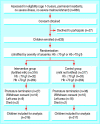Effects of fortified milk on morbidity in young children in north India: community based, randomised, double masked placebo controlled trial
- PMID: 17132678
- PMCID: PMC1779825
- DOI: 10.1136/bmj.39035.482396.55
Effects of fortified milk on morbidity in young children in north India: community based, randomised, double masked placebo controlled trial
Abstract
Objective: To evaluate the efficacy of milk fortified with specific multiple micronutrients on morbidity in children compared with the same milk without fortification.
Design: Community based, double masked, individually randomised trial.
Setting: Peri-urban settlement in north India.
Participants: Children (n=633) aged 1-3 randomly allocated to receive fortified milk (n=316) or control milk (n=317).
Intervention: One year of fortified milk providing additional 7.8 mg zinc, 9.6 mg iron, 4.2 microg selenium, 0.27 mg copper, 156 microg vitamin A, 40.2 mg vitamin C, 7.5 mg vitamin E per day (three feeds).
Main outcome measures: Days with severe illnesses, incidence and prevalence of diarrhoea, and acute lower respiratory illness.
Results: Study groups were comparable at baseline; compliance in the groups was similar. Mean number of episodes of diarrhoea per child was 4.46 (SD 3.8) in the intervention (fortified milk) group and 5.36 (SD 4.1) in the control group. Mean number of episodes of acute lower respiratory illness was 0.62 (SD 1.1) and 0.83 (SD 1.4), respectively. The fortified milk reduced the odds for days with severe illnesses by 15% (95% confidence interval 5% to 24%), the incidence of diarrhoea by 18% (7% to 27%), and the incidence of acute lower respiratory illness by 26% (3% to 43%). Consistently greater beneficial effects were observed in children aged < or =24 months than in older children.
Conclusion: Milk is well accepted as a means of delivery of micronutrients. Consumption of milk fortified with specific micronutrients can significantly reduce the burden of common morbidities among preschool children, especially in the first two years of life.
Trial registration: NCT00255385 [ClinicalTrials.gov].
Conflict of interest statement
Competing interests: None declared.
Comment in
-
Iron and zinc deficiency in children in developing countries.BMJ. 2007 Jan 20;334(7585):104-5. doi: 10.1136/bmj.39094.513924.BE. BMJ. 2007. PMID: 17235055 Free PMC article.
References
-
- Gross R, Benade S, Lopez G. The international research on infant supplementation initiative. J Nutr 2005;135:628-30S. - PubMed
-
- Ramakrishnan U. Prevalence of micronutrient malnutrition worldwide. Nutr Rev 2002;60:S46-52. - PubMed
-
- Bhaskaram P. Micronutrient deficiencies in children—the problem and extent. Indian J Pediatr 1995;62:145-56. - PubMed
-
- Calder PC, Kew S. The immune system: a target for functional foods? Br J Nutr 2002;88(suppl 2):165-77. - PubMed
Publication types
MeSH terms
Associated data
LinkOut - more resources
Full Text Sources
Other Literature Sources
Medical

